Before we start Year One of the Silver Age, here is everything in Earth-1 Bruce Wayne’s life (starting with his birth) that leads up to the moment he decides to don the cape and cowl of the Bat.[1][2]
_______________________________
_______________________________
__________________________________________________________________________________________
1946-1949
_______________________________
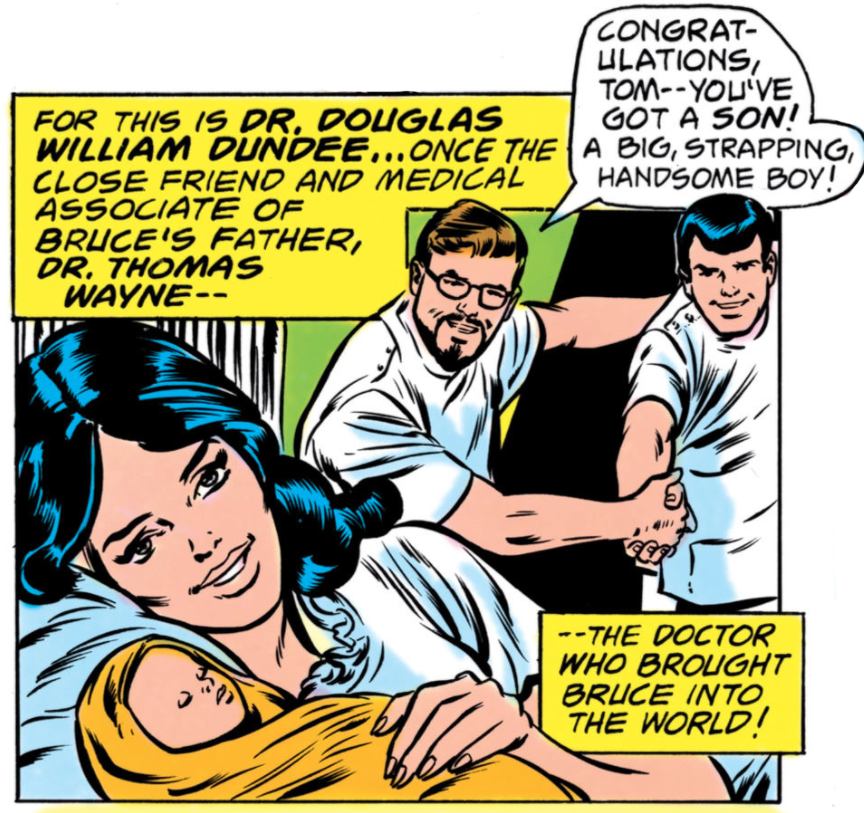
Batman #304 Part 2 by David Vern Reed, Win Mortimer, Frank Chiaramonte, & Jerry Serpe (1978)
February 1946[3]
Flashback from Batman #304 Part 2. Bruce Wayne is born to Dr. Thomas Wayne and Martha Wayne in Gotham City, USA. Thomas Wayne’s associate and friend Dr. Douglas William Dundee delivers Bruce. Philip Wayne (Thomas’ brother) and Silas Wayne (Thomas’ uncle) likely meet newborn Bruce shortly after his birth. Bruce will interact with these members of his family and Dr. Dundee frequently, moving forward. (Dr. Dundee will be Bruce’s primary physician for the rest of his life. While we won’t see most of his appointments on our chronology, we should imagine them occurring at least once a year every year, moving forward.)
1946
Reference in World’s Finest Comics #146. Baby Bruce summer vacations with his parents a few hours outside of Gotham, next door to their friend, scientist Dr. Thomas Ellison. Dr. Ellison takes a liking to little Bruce and will babysit him often in the years to come.
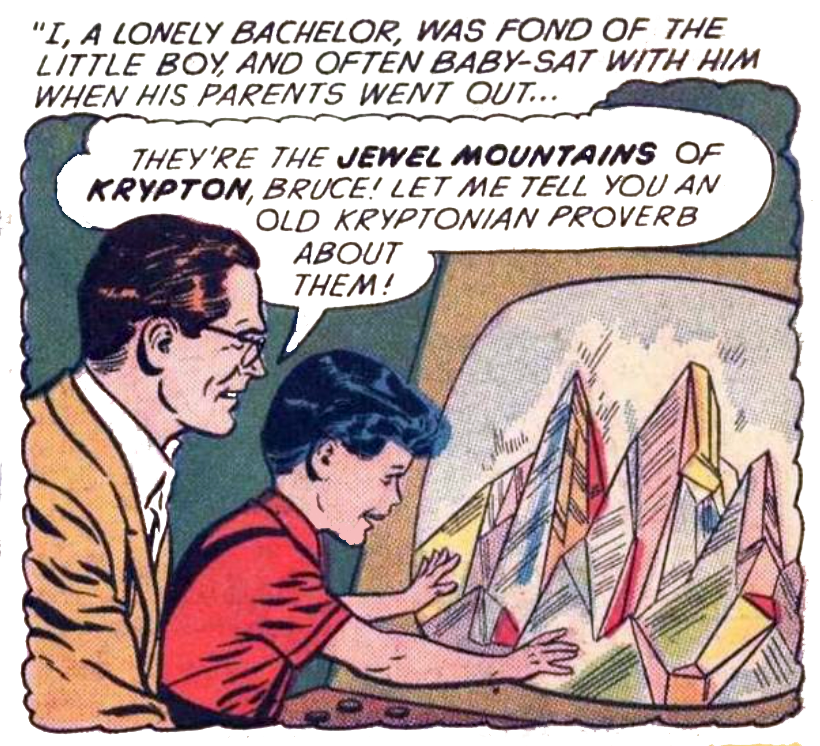
World’s Finest Comics #146 by Edmond Hamilton, Curt Swan, & Sheldon Moldoff (1964)
June 1949[4]
Flashback from World’s Finest Comics #146. As he always does, a three-year-old Bruce vacations with his parents at their regular summer home next door to Dr. Thomas Ellison’s property. Using a special telescope, Dr. Ellison had, years prior, discovered the planet Krypton. Using this same telescope, Dr. Ellison had been able to view Krypton at street level for years. This allowed him to learn the Kryptonian language and read lips to see what Kryptonians were talking about. The neglectful Wayne parents allow little Bruce to wander over to the doctor’s house where, over the course of several weeks, Dr. Ellison shows Bruce live feeds of Krypton, creepily dresses him in Kryptonian-styled clothes, and takes pictures of him flying on wires and bending plastic bars. (How Dr. Ellison would have known that the rays of a white sun/yellow dwarf sun would give Kryptonians super-powers is beyond me, but that’s probably my smallest gripe with this ridiculous story.) Upon learning of Krypton’s imminent destruction, Dr. Ellison builds a neutralizing ray, which ultimately fails to prevent planetary collapse. Krypton explodes into oblivion and little baby Kal-El is secretly sent (by his dying parents Jor-El and Lara) rocketing to Earth.
1949
Reference in The Brave and The Bold #83. Little Bruce meets his dad’s best friend, Professor Bruner, for the first time. Bruner, as Thomas’ best mate, will be around quite often. Bruce will have the utmost respect and admiration for the professor.
1949
Reference in Detective Comics #496. Little Bruce, like most three-year-olds, comes to love nursery rhymes and sing-a-long songs.
_______________________________
__________________________________________________________________________________________
1950
1950
Reference in The Brave and The Bold #188. Bruce and his family go to idyllic Loon Lake, located a few hours outside of Gotham. Little Bruce swims there and loves it dearly. Bruce and his family will visit as often as they can for the next handful of years (all though we will have to imagine these trips peppered throughout our timeline).
1950
Reference in Batman #111 Part 2. Bruce learns that he was patronymically named after his father’s estranged cousin, Bruce N Wayne.
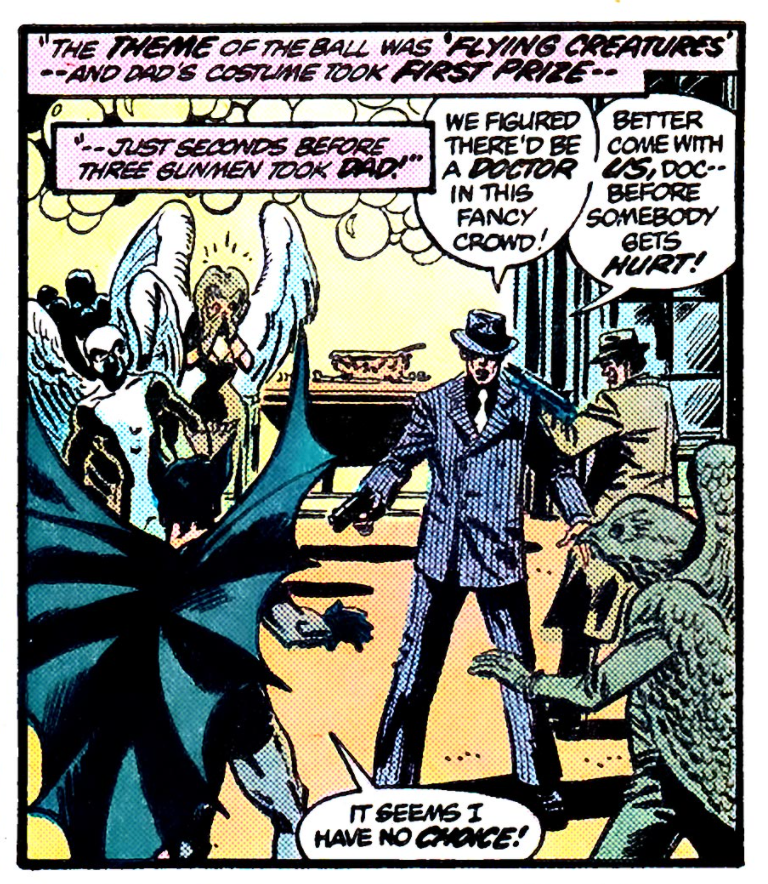
The Untold Legend of the Batman #1 by Len Wein, John Byrne, Jim Aparo, & Glynis Oliver (1980)
1950
Flashback from The Untold Legend of the Batman #1 and The Untold Legend of the Batman #3—and also referenced in The Untold Legend of the Batman #1. A roughly four-year-old Bruce Wayne is present at a masquerade party held by his parents at their Wayne Manor home. Thomas Wayne wears a bat costume. During the ball, Thomas is kidnapped by injured gangster Lew Moxon, who wants the gifted doctor to perform surgery on him. Rather than operate, Thomas beats up Moxon and delivers him to James Gordon, a new lieutenant with the Gotham City Police Department. Gordon is around twenty-six or twenty-seven-years-old at this juncture. We know Gordon’s age from Batman #357, in which we learn he is sixty in 1983. Batman #328 tells us that Gordon was a rookie beat cop in 1945.
1950
Flashback from The Untold Legend of the Batman #3. Bruce plays with his dad, telling him that he wants to be a doctor when he grows up.
_______________________________
__________________________________________________________________________________________
1952
1952
Reference in The Brave and The Bold #148. Christmas. Young Bruce admires the famous holiday decor at Lacey’s Department Store, something he will admire for the rest of his life.
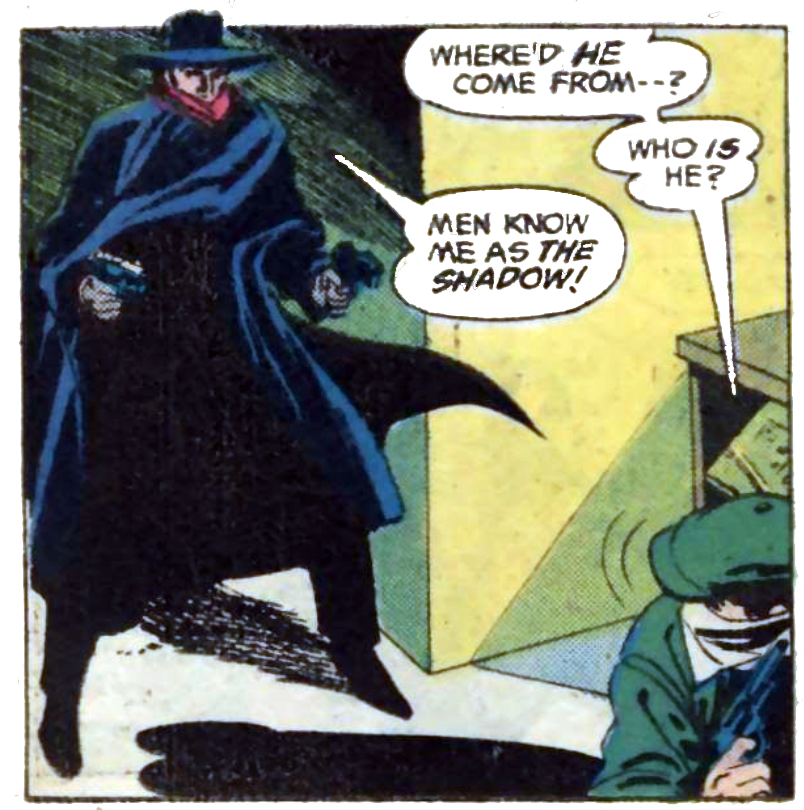
Batman #259 by Denny O’Neil, Irv Novick, & Dick Giordano (1974)
1952
Flashback from Batman #259—and referenced in Batman #253 and Detective Comics #446. Bruce goes with his dad on a visit to an office building. Concurrently, robbers led by teenage crook Willy Hank Stamper steal the priceless Starlight Tiara and then enter the same office building in an attempt to flee from famous pulp hero The Shadow (Kent Allard aka Lamont Cranston)! When Stamper points his gun at innocent bystander Mildred Miller, Thomas Wayne saves her life. As the Shadow enters the scene, Thomas daringly also saves the lives of Bruce and jeweler Thornton Swofford. The Shadow, with his Colt 1911s a-blazing, takes down the bad guys and helps a terrified Bruce up to his feet. Before vanishing, the Shadow hands Stamper’s gun to Thomas, who holds the villain at bay until cops arrive. Bruce will forever be changed by this encounter. Becoming instantly obsessed with the Shadow, Bruce will follow every news story about him and learn as many details about every Shadow case he possibly can, moving forward. The Shadow, who will retire from crime-fighting at some point in the next decade, will be one of the biggest inspirations on Bruce’s life. Also of note, Mildred Miller is so emotionally traumatized by what has occurred, she slips into a permanent near-catatonic state and is admitted to an old folks home. Feeling sorry for Mildred Miller, Thomas will become close friends with her and look after her at the old folks home from time-to-time. As a family friend, Bruce will also become relatively close with Mildred. He’ll remain in contact with Mildred long into his adulthood.
1952
Reference in The Brave and The Bold #184. Bruce meets his dad’s friend and accountant, Amos Randolph. Bruce takes a liking to the kind Randolph and they become close. Thomas, Martha, and Bruce pose for a photo with Randloph, which gets developed, framed, and either hung or stored in Wayne Manor. While not seen on our timeline, Randolph will visit the Waynes from time to time in the coming years. (Unknown to the Waynes, Randolph is a crook that is in league with gangster Spurs Sanders.)
1952
Reference in Batman #213. Bruce joins the Sea Scouts. He will be active with them for years to come, learning lots of neat stuff along the way.
_______________________________
__________________________________________________________________________________________
1953-1954
1954
Reference in The Brave and The Bold #171. With puberty come strange new emotions and feelings. Bruce studies a Matthew Brady photo book about the US Civil War, learning about Martha Jennings, the “Florence Nightingale of the Civil War.” Bruce develops quite a crush on this historical figure.
1954
Reference in Detective Comics #352. Bruce learns to play tennis. He will play tennis as a hobby for the rest of his life.
1954
Reference in World’s Finest Comics #196, Batman #260, Batman #336, and Detective Comics #565. Bruce takes a liking to cinema, especially Westerns, Marx Brothers comedies, and Greta Garbo movies. Generally speaking, Bruce will be an avid film buff and watch all types of cinema throughout his life.
1954
Reference in Detective Comics #500 Part 5. Bruce hears the Frank Sinatra song “Three Coins in the Fountain,” which was originally from the film Three Coins in the Fountain. It’s unknown if Bruce sees the film or simply hears the song, but the catchy tune does stick in his brain.
_______________________________
__________________________________________________________________________________________
1955
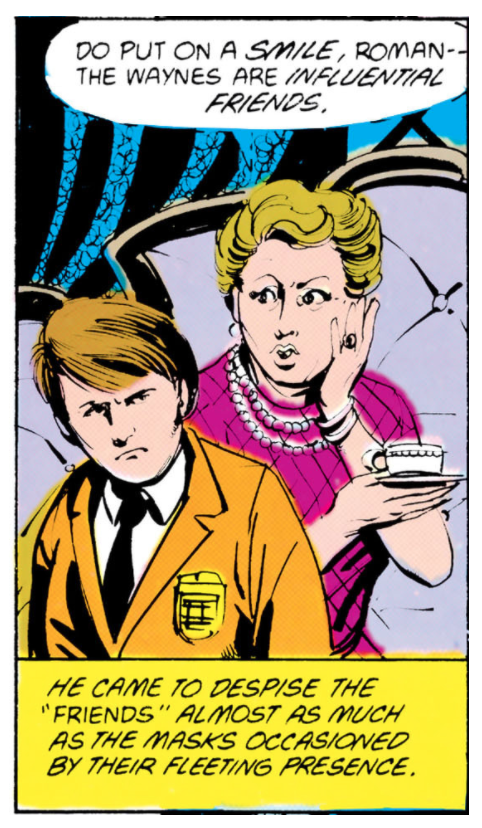
Batman #386 by Doug Moench, Tom Mandrake, Adrienne Roy (1985)
1955
Flashback from Batman #386. Bruce’s parents introduce him to their friends, the Sionis family (Charlies Sionis, Mrs. Sionis, and Roman Sionis), who run the Janus Cosmetics company. Mr. and Mrs. Sionis encourage their awkward son Roman to befriend Bruce. Bruce and Roman have playdates (and will continue to have them for years to come), although they won’t ever really hit it off.
1955
Reference in Crisis on Infinite Earths #2. Bruce watches Peter Glenville’s The Prisoner, a film starring Alec Guinness.
1955
Reference in Batman #392. Bruce watches Disney’s Lady and the Tramp.
_______________________________
__________________________________________________________________________________________
1956
1956
Reference in World’s Finest Comics #266. Bruce takes up marbles as a hobby, becoming quite skilled in the game.
1956
Reference in Batman #268. Bruce learns to roller skate and ice skate.
1956
Reference in Batman #244. Bruce learns to ski. He will ski on-and-off, moving forward, becoming quite skilled at the sport/hobby by the time he reaches adulthood.
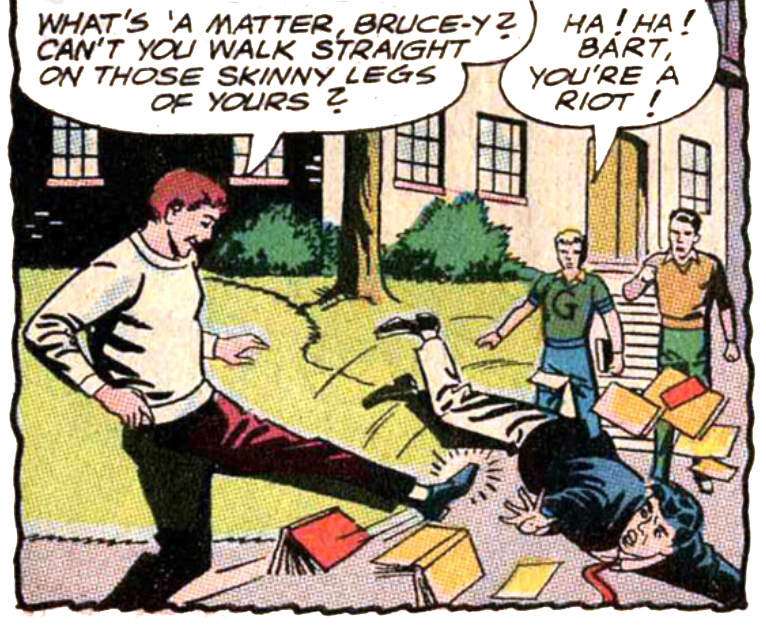
Detective Comics #370 by John Broome, Sheldon Moldoff, & Joe Giella (1967)
1956
Flashback from Detective Comics #370. Ten-year-old Bruce gets mercilessly beaten-up by an older school bully named Bart Lambert over the course of months. Skinny Bruce is unable to put up a fight or defend himself, so he decides to dedicate his life to exercise, fitness, and bulking up with weight training. Bruce continues taking a wallop from Lambert, but he begins working out. Eventually, Lambert moves to the other side of the country before Bruce is ever strong enough to confront him or get revenge. Bruce will have nightmares about Lambert for years to come.
1956
Reference in Batman #321. Bruce learns to water-ski.
1956
Reference in The Brave and The Bold #83. Thomas Wayne’s best friend Professor Bruner (along with an unknown partner) fathers a baby boy named Lance Bruner. Bruce meets the newborn.
_______________________________
__________________________________________________________________________________________
1957
1957
Reference in World’s Finest Comics #261. Bruce begins reading Buck Rogers comic strips, becoming a big fan.
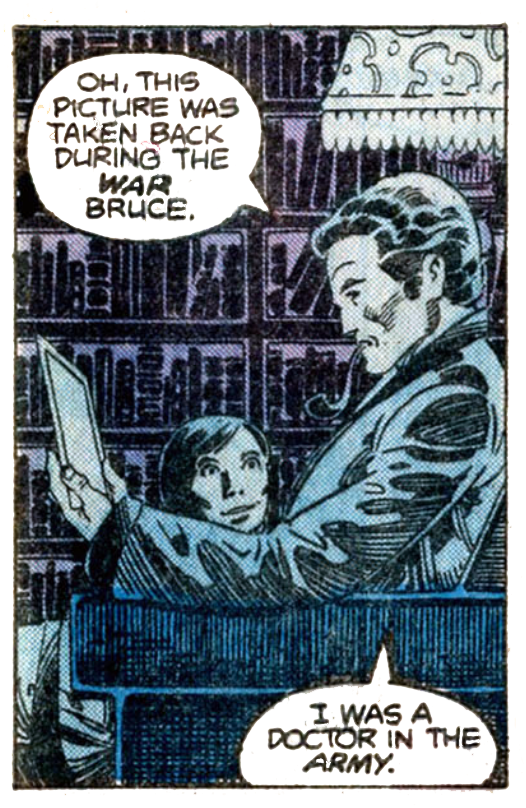
Detective Comics #481 Part 5 by Jim Starlin, P Craig Russell, & Tatjana Wood (1979)
1957
Flashback from Detective Comics #481 Part 5. Bruce finds a framed picture of his dad in a military uniform with other uniformed men, including Red Larken, Ron Thurgood, Bruno Clark, and Xavier Simon. Thomas explains that, when he was only a teenager, he was a medic in WWI. Thomas tells Bruce that Simon “mistreated” a woman, so they all testified against him, sending him to jail in 1918. A reference in Batman #120 Part 2 confirms that Thomas Wayne worked as a doctor for the American Expeditionary Forces during WWI, eventually attaining the rank of colonel after the war ended. (Note that Bruce finding his dad’s army photo is said to take place less than a year before the death of the Waynes, yet it also paradoxically says that Bruce is five-years-old. Bruce would be eleven-years-old by this point.)
1957
Reference in Batman #342. Bruce discovers and explores the caverns beneath Wayne Manor. He will spend many days exploring these caverns for fun, moving forward. (Of course, these caverns will one day become the Batcave.)
1957
Reference in The Brave and The Bold #184. Christmas. Bruce celebrates Christmas with his family. Amos Randolph visits Wayne Manor and gives Bruce a red toy fire engine.
_______________________________
__________________________________________________________________________________________
1958
1958
Reference in Batman Annual #9 Part 1. Bruce begins doing various art projects, taking a specific liking to sculpture.
1958
Reference in World’s Finest Comics #315. A citywide blackout darkens all of Gotham. Bruce and his family help their fellow Gothamites during the crisis. Bruce takes note about how the citizens of Gotham pull together to help one another. The spirit of camaraderie is alive and well.
1958
Reference in Batman Special #1. March. Bruce attends a black tie charity banquet with his parents.
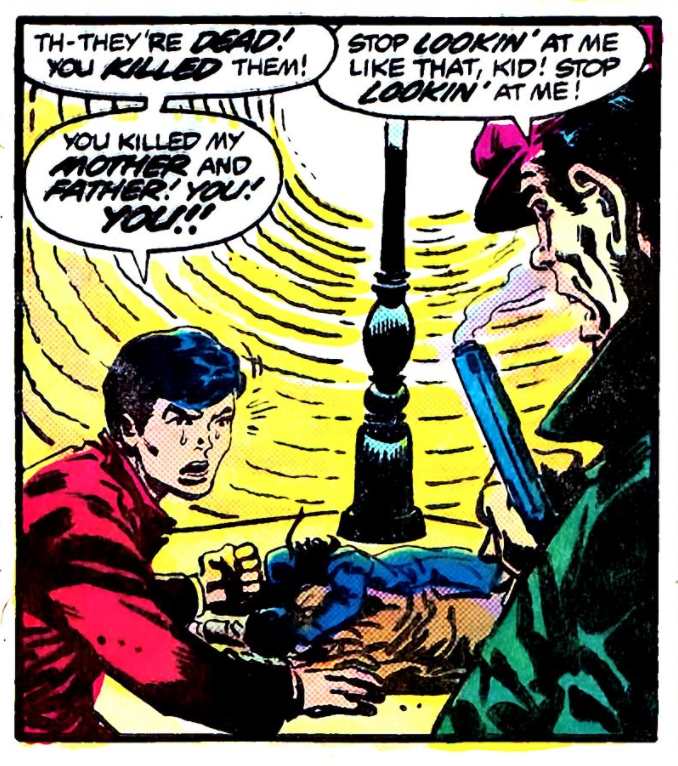
The Untold Legend of the Batman #1 by Len Wein, John Byrne, Jim Aparo, & Glynis Oliver (1980)
1958
Flashback from The Untold Legend of the Batman #1, Batman with Robin the Boy Wonder Sunday News Strip 7/30/1967, Batman with Robin the Boy Wonder Sunday News Strip 8/6/1967, Batman #200, Batman #208, Batman #232, Batman #259, Batman #300-301, Batman with Robin the Boy Wonder News Strip 11/9/1971 to 11/13/1971, Detective Comics #439, Detective Comics #457, Detective Comics #483, Detective Comics #500 Part 1, World’s Finest Comics #258 Part 2, The Brave and The Bold #190, World’s Finest Comics #285, Batman and The Outsiders #1, Detective Comics #535, Batman Special #1, World’s Finest Comics #296, Batman Annual #9 Part 1, World’s Finest Comics #321, and Detective Comics #560—and also referenced in The Untold Legend of the Batman #1, Batman with Robin the Boy Wonder Sunday News Strip 7/30/1967, Batman #248, Batman #380, World’s Finest Comics #288-289, and Batman and The Outsiders #13. June 26. The Wayne tragedy occurs.[5][6] Bruce finishes a sculpture art project and then joins his parents for a night on the town. While walking home after viewing an unspecified Marlon Brando movie, the Waynes are mugged on Park Row, which will now be known forever more as “Crime Alley.”[7] (Note that Park Row is a street upon which the Park Row neighborhood is centered. So, Park Row is both a thoroughfare and district. Likewise, Crime Alley will be both a thoroughfare and district.) Thomas is shot dead and Martha suffers a fatal heart attack during the assault. The murders are committed by Joe Chill as a secret paid revenge hit ordered by Lew Moxon, who has latterly been granted an early release from prison. (As seen in World’s Finest Comics #321, the super-villain Chronos, in an attempt at psychological torture, sends Batman time-traveling from 1985 to this moment, forcing him to rewatch the murders from the shadows. So, amazingly, an adult Bruce is also present here on Park Row. Superman arrives to help Batman return to 1985.) Dr. Leslie Thompkins, who owns a clinic on Park Row, cares for a grief-stricken young Bruce and takes him home. Shortly thereafter, a sad funeral is held at Crown Hill Cemetery. Presumably, most of the extended Wayne family is in attendance, including Philip Wayne (Thomas’ brother), elderly Silas Wayne (Thomas’ uncle), Bruce’s distant cousin Vanderveer “Van” Wayne, Jane Wayne (Van’s wife), baby Vanderveer “Van” Wayne Jr (Van Sr and Jane’s son),[8] Bruce’s elderly unnamed Scottish relative, and Bruce’s Scottish relative’s unnamed spouse. We can assume the Sionis family is present too. Crown Hill Cemetery’s trustee Arthur Childress is also present. Bruce meets Childress, and he will remain a constant figure in Bruce’s life, moving forward. Later, as referenced in Detective Comics #367-368, The Brave and The Bold #89, and Detective Comics #481 Part 5, Bruce’s parents’ wills are read. Bruce is given the entire Wayne family fortune (including a ton of real estate) and made heir to its business enterprises. Bruce is left his father’s personal mementos in a large chest, which Bruce will keep until adulthood. Bruce is also left his father’s prize possessions, the priceless Rajah Ruby and some original Modigliani paintings. (The Modiglianis immediately get hung up in Wayne Manor. The Rajah Ruby goes into a Wayne Manor safe, where it will stay until Bruce’s adulthood.) Likewise, as referenced in Detective Comics #446 and Batman #271, Bruce is left an entire storage warehouse filled with objets d’art and antiques. Bruce will treasure fine art and antiques, especially antique rugs, for the rest of this life. Not long after, Bruce collapses to his knees before the graves of his parents and vows to avenge them. Dr. Leslie Thompkins initially cares for the orphaned Bruce before he goes into legal custody of his dad’s brother, Uncle Philip Wayne. Ironically, Joe Chill’s mother, Alice Chilton, becomes Bruce’s full-time nanny. Bruce will call her “Mom Chilton.” She will teach him rectitude and integrity, becoming a something of a surrogate mother to him. From this point on, young Bruce will train non-stop.[9]
1958
Reference in The Untold Legend of the Batman #1. Bruce, as the only witness to his parents’ deaths, testifies before a court that they were attacked by an unknown mugger. Unable to provide more information, the killer (Joe Chill) is never caught and remains free. Likewise, no investigation into Lew Moxon ever takes place, which allows him to remain untouched by the law, despite the fact that he secretly put the hit on the Waynes.
1958
Reference in Detective Comics #500 Part 1. Bruce begins having recurring nightmares about the death of his parents. He will have these nightmares for decades to come. They won’t stop until Joe Chill’s death in 1974.
1958
Flashback from Batman Annual #9 Part 1 and Detective Comics #560—and referenced in Detective Comics #332 and Detective Comics #344. Bruce’s begins what will soon become non-stop training in various fields related to crime-fighting. He symbolically smashes a sculpture he finished on the night of his parents’ deaths, picking up a fingerprint kit and chemistry set to focus on those instead. Bruce also begins spending a lot of time at the library. However, the dedicated young soldier won’t just focus on detective studies, noetic matters, and the gym. In fact, the Silver/Bronze Age Bruce Wayne might be the nonpareil iteration of the character because he will be the only version to master multiple visual arts media as well. While Bruce may have destroyed his sculpture as a symbolic act, the boy isn’t really done with artistic ventures. He begins drawing and woodcarving, which will soon morph into serious hobbies. He will eventually become a professional-grade sketch artist and master wood carver, so we can imagine him drawing and carving frequently, moving forward on our timeline.
_______________________________
__________________________________________________________________________________________
1959
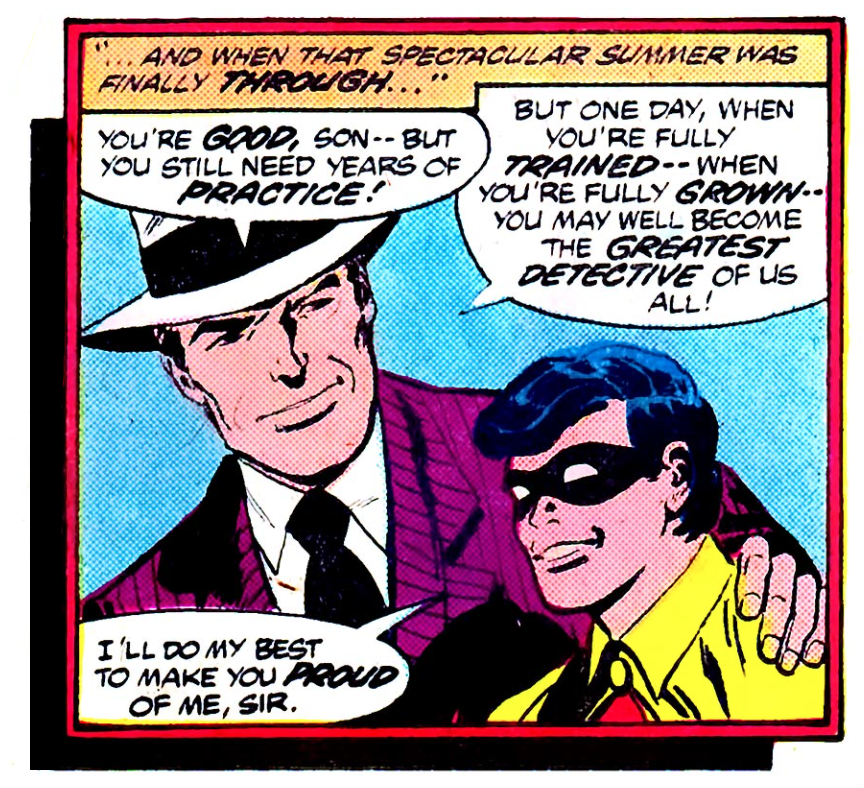
The Untold Legend of the Batman #1 by Len Wein, John Byrne, Jim Aparo, & Glynis Oliver (1980)
1959
Flashback from The Untold Legend of the Batman #1 and Batman #213. Less than a year after his parents’ murder, Bruce wears a proto-Robin costume (of his own design) and spends a summer training with famous super-detective Harvey Harris. Bruce and Harvey go on several adventures, solving several crimes in the process. Harvey teaches Bruce everything he knows.
1959
Reference in Detective Comics #360, Detective Comics #405, and Justice League of America #152. Bruce reads all about Harry Houdini and begins training in escape artistry. In conjunction, Bruce also learns how to tie speciality purpose knots. Bruce will practice escapology for the rest of his life.
_______________________________
__________________________________________________________________________________________
1960
1960
Flashback from Batman #304 Part 2. Longtime family friend Dr. Douglas Dundee meets with Bruce. They visit Bruce’s parents’ graves together.
1960
Reference in The Brave and The Bold #189. May. Bruce reads about the capture of fugitive SS-Obersturmbannführer Adolf Eichmann in South America at the hands of Israeli Mossad agents led by Nazi hunter Leon Weiner (an analogue for Simon Wiesenthal, who captured Eichmann in real life).
_______________________________
__________________________________________________________________________________________
1961
1961
Reference in The Brave and The Bold #77. Bruce begins high school, showing a strong aptitude and affinity for chemistry. This should come as no surprise since Bruce picked up a chemistry set right after his parents died.
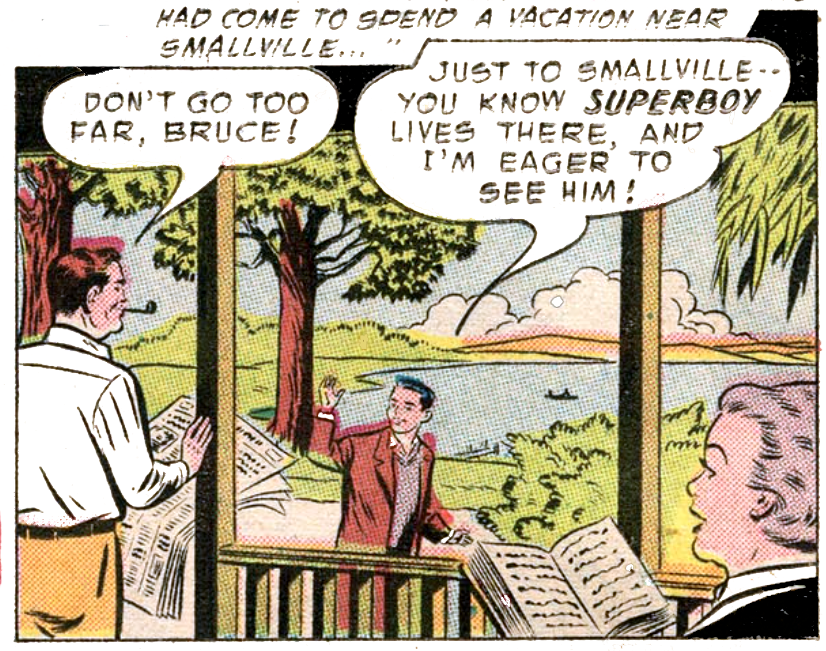
World’s Finest Comics #84 by Edmond Hamilton, Dick Sprang, & Stan Kaye (1956)
1961
Flashback from World’s Finest Comics #84. A roughly fifteen-year-old Bruce vacations near Smallville with his parents—meaning guardians Uncle Philip and Mom Chilton (as retconned and re-shown via flashback from World’s Finest Comics #271). During this stay of rustication, young Bruce trails both crook Thad Linnis and the Kryptonian Boy of Steel known as Superboy (Clark Kent/Kal-El). Bruce discovers that Clark is Superboy, while keeping it secret from Linnis.
1961
Reference in DC Special Series #15 (Batman Spectacular 1978) Part 1. Bruce, old enough to take stock in his parents’ material belongings and in his future estate, familiarizes himself with the lavish items in Wayne Manor. In direct relation to this, Bruce begins studying design and interior decoration.
1961
Reference in Batman #278. Bruce begins learning all he can about a new type of commercial robotics invented by Disney scientists known as audio-animatronics.
_______________________________
__________________________________________________________________________________________
1962
1962
Flashback from Batman #224. Bruce gets into jazz music and begins collecting old records. One of his favorite musicians is Blind Buddy (Charles Holden). Bruce will listen-to and enjoy jazz for the rest of his life.
1962
Flashback from Detective Comics #370. Teenage Bruce, who has constantly worked out for years, hits a growth spurt and takes notice of how strong he has become. He is reminded of the trauma Bert Lambert caused him and how it convinced him to begin exercising in the first place. Bruce would love to stick it to Lambert, but the old bully is long out of his life, so Bruce does his best to block the memory of the jerk from his mind.
1962
Flashback from Batman Annual #9 Part 1. Some high school baseball players make fun of Bruce for always having his nose in a book. One of Bruce’s co-eds takes a romantic liking to him, but her friends tell her to stay away from the donnish enigma. Bruce has earned a reputation as a distracted and slightly off-kilter loner. Bruce will continue to study and to train his mind, spending many days at the library instead of out making friends.
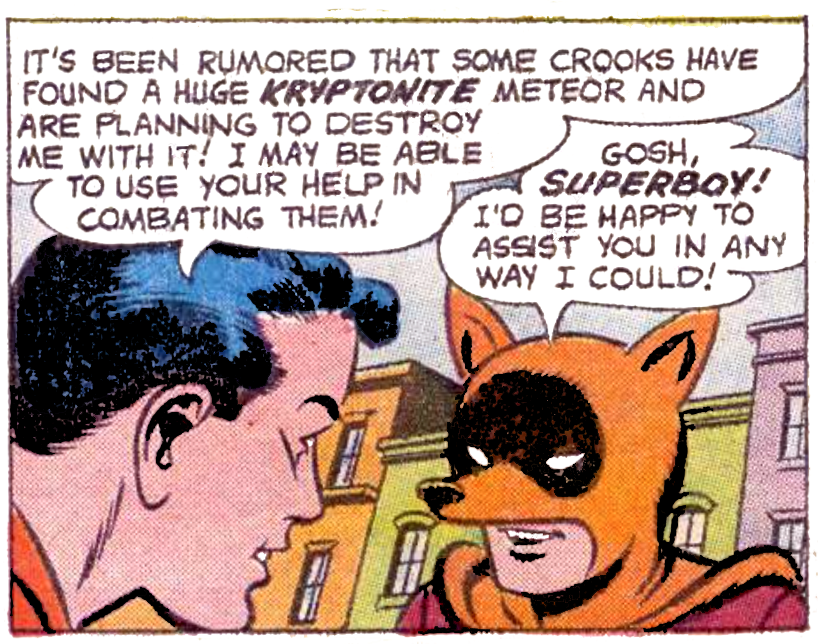
Adventure Comics #275 by Jerry Coleman & George Papp (1960)
1962
Adventure Comics #253, Adventure Comics #275, and re-shown via flashback from World’s Finest Comics #271.[10] Robin (Dick Grayson), from 1969, goes back in time and meets Superboy. A few weeks later, Bruce (now sixteen-years-old) gets his driver’s license and learns to drive both cars and motorcycles. Bruce and his family—Uncle Philip and Mom Chilton—then briefly move to Smallville (as told in the apocryphal and error-filled Adventure Comics #275, which was later retconned and re-shown via flashback in World’s Finest Comics #271). In Smallville, Bruce meets Lana Lang and becomes the costumed Flying Fox to fight alongside Superboy. After their team-up, Superboy uses his wheel-hypnosis technique to erase Bruce’s knowledge of his secret ID. Superboy also uses the wheel-hypnosis on himself to erase knowledge that Bruce will grow up to become Batman, a fact that he knew both from viewing a device known as the Time Telescope and from recently meeting a time-traveling Robin. The hypnosis/autosuggestion is so effective, it basically erases any of their memories relating one to the other.
1962
Reference in Batman #215 and Detective Comics #418. Bruce begins collecting cars. (It’s also highly likely that his mom and dad already kept a bunch of cars at Wayne Manor, so he’d be inheriting their collection.) For years to follow, he will fill the Wayne Manor garage with a variety of brand new and antique roadsters. Bruce will drive most of the cars, begin learning auto mechanics, and work on some of the cars too. Notably, Bruce will put a modern engine into at least one of the antiques.
1962
Reference in Batman with Robin the Boy Wonder News Strip 11/1/1968. Bruce becomes very active in track and field sports, competing and training in all events. Bruce’s hope is to compete in the upcoming Olympics, focusing on hammer throw as his main sport. Bruce will focus in hammer throwing for the next two years straight.
1962
Reference in Detective Comics #409. Bruce begins following football avidly. Not only will he follow Gotham College’s team, but he will follow Hudson University football too, with specifically interest in their top linebacker Tracy Calhoun, who will go on to win the title of Hudson All-Star Athlete at the end of the season. Bruce will follow college football closely, watching as many games on TV as he can. Presumably, Bruce will be a football fan for the rest of his life.
1962
Reference in The Brave and The Bold #88. Bruce picks up fencing, in which—you guessed it—he will eventually become an expert.
1962
Reference in Batman #241. Bruce begins learning how to vocal impersonations and practicing them regularly. He will eventually become an expert at altering his voice and copying other’s voices, even after only briefly hearing them speak.
1962
Reference in Batman #268. Bruce learns how to tie a rope into a loop and how to use it as a lasso.
1962
Reference in Batman #289. Bruce begins doing the daily Times crossword puzzle, a habit he’ll do whenever he has free time, for the rest of his life.
_______________________________
__________________________________________________________________________________________
1963
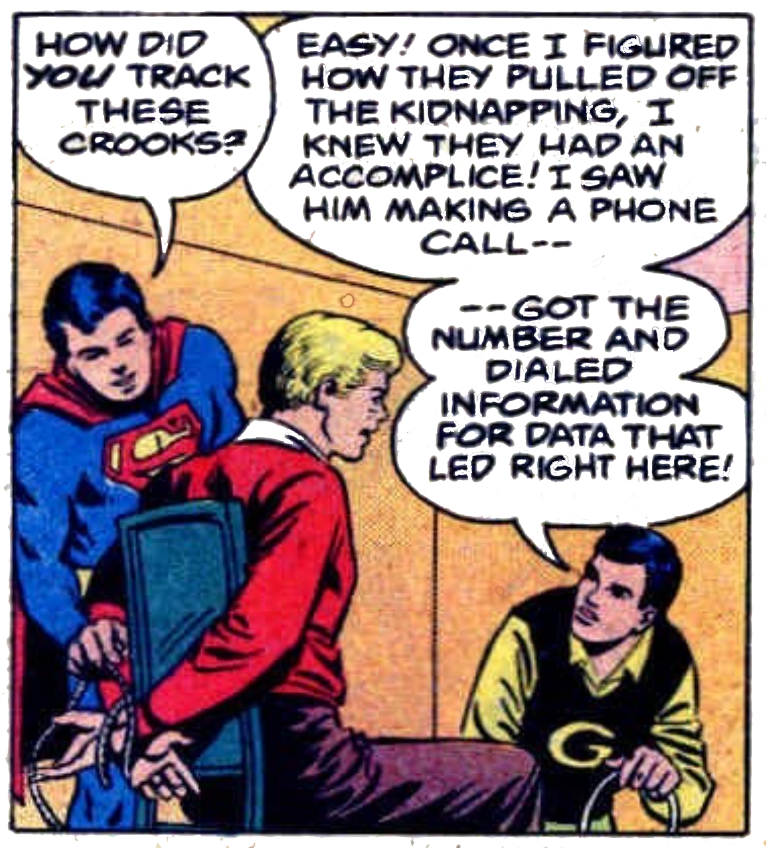
Superboy Spectacular #1 Part 7 by E Nelson Bridwell, Curt Swan, Joe Giella, & Gene D’Angelo (1980)
1963
Superboy Spectacular #1 and later retconned and re-shown via flashback from World’s Finest Comics #271. A roughly seventeen-year-old Bruce joins a junior baseball team, the Gotham Greyhounds, becoming the team’s star player. During a baseball tournament held in Gotham City, the Greyhounds play against a team from Smallville. Bruce meets Pete Ross and helps Superboy solve a racketeering and kidnapping case. This item was originally told in the slightly apocryphal Superboy Spectacular #1, which was later retconned and re-shown via flashback in World’s Finest Comics #271.
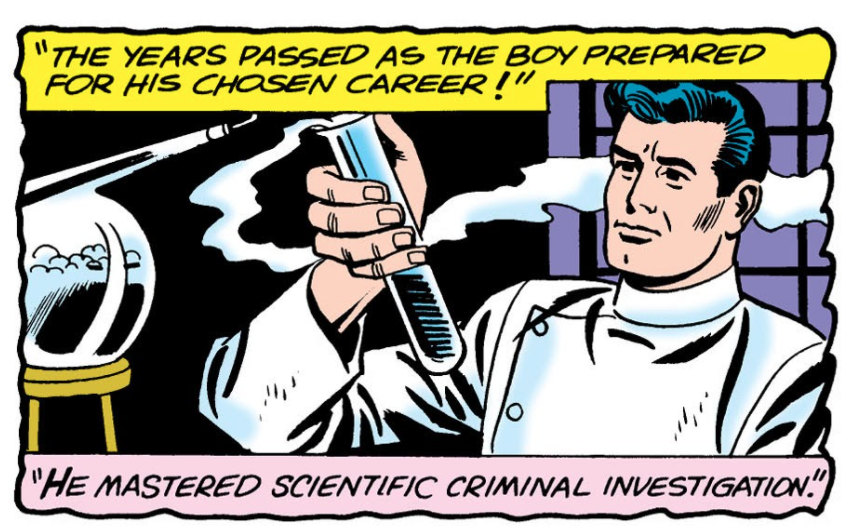
Batman #200 by Mike Friedrich, Chic Stone, & Joe Giella (1968)
1963
Flashback from Batman with Robin the Boy Wonder Sunday News Strip 8/6/1967, Batman #200, Batman #213, Batman #232, Batman #301, Batman Special #1, and Detective Comics #560—and also referenced in Batman #133 Part 2, The Brave and The Bold #71, Batman #191 Part 1, Detective Comics #370, Batman with Robin the Boy Wonder News Strip 11/6/1968, Batman with Robin the Boy Wonder News Strip 3/16/1969, The Brave and The Bold #80, Batman #209, Detective Comics #388 Part 1 Epilogue, Superman’s Girl Friend Lois Lane #100, Detective Comics #405, Detective Comics #411, The Brave and The Bold #93, Batman #222, Batman #227, Batman #232, Batman #244, Batman #260, Batman #279, Batman #283, Batman #298, Batman #300, World’s Finest Comics #214, Batman #257 Part 1, Batman #319, Batman #327 Part 2, Batman #337, World’s Finest Comics #232, Detective Comics #453 Conclusion, Detective Comics #485, Detective Comics #492 Part 1, Detective Comics #500 Part 7, The Brave and The Bold #132, DC Special Series #1 (5 Star Super-Hero Spectacular 1977) Part 5, DC Special Series #15 (Batman Spectacular 1978) Part 3, Justice League of America #156, The Brave and The Bold #158 Part 1, The Brave and The Bold #188, World’s Finest Comics #258, and World’s Finest Comics #268. A seventeen-year-old Bruce begins privately studying multiple sciences, including advanced chemistry, botany, pharmacology, physics, electronics, entomology, ecology, zoology, geology, geography, astronomy, selenography, oneirology, acoustics, optometry, medicine, epidemiology, and genetics. He also begins learning animal, marine, avian, and human anatomy/biology. Additionally, he begins dabbling in aerospace, mechanical, radio, explosives, and railway engineering. Bruce gobbles-up chess, word games, riddles, puzzles, art history, sociology, anthropology, and world mythology too. (Bruce will often daydream about mythological creatures, moving forward.) Bruce also delves deeply into demonology, mysticism, supernaturalism, astrology, superstition, and occult studies. While being a devoted researcher and believer in arcane hermeticism, Bruce will always retain a healthy dose of skepticism, knowing full well that charlatans abound in the field. (Note that the polymathic Bruce, beyond these items listed above, will study nearly everything imaginable, becoming a master in almost everything he touches.) Bruce also augments his workout routine and begins training in various physical activities, including horseback riding, boomerang throwing, trapeze, power-lifting, advanced gymnastics, acrobatics, swimming, ice climbing, rock climbing, Native American wrestling, judo, karate, savate, boxing, kung fu, aikido, jiu jitsu, kyusho jitsu, and Sumatran pencak silat (aka silek). (While training in silek, Bruce notes how it seems like the most dangerous of the martial arts, and he’ll move forward hoping never to face anyone who has mastered the technique. And while training in boxing, Bruce will study film of Sugar Ray Robinson from the late 1940s.)[11] Bruce also trains in defensive techniques against a variety of weapons. Already active in fencing and Olympic track-and-field training, Bruce continues focusing on hammer throwing, but also begins extra work on perfecting his archery and javelin throwing ability. He also learns all he can about survivalism, hunting, and trapping—although, as an animal lover, Bruce won’t actually hunt or trap because he feels those practices are morally and ethically wrong. (Bruce will continue training in all of these things for the rest of his life.)
1963
Reference in Detective Comics #455. As part of his studies, Bruce reads about 19th century experimental physician Dr. Gustav Decobra.
1963
Reference in Detective Comics #367. Bruce learns first aid and CPR from the American Red Cross Handbook.
1963
Reference in Detective Comics #385. Postal carrier Herbert Small begins working the mail route that delivers to Wayne Manor. He’ll drop off mail six days a week, but Bruce won’t ever pay him any attention.
1963
Reference in The Brave and The Bold #89. Bruce learns about a dark part of Gotham’s history involving the religious sect known as the Hellerites. In the early 19th century, the ascetic Hellerites settled in Gotham, but were immediately ostracized for their strange customs. After their settlement was burned to the ground, the Hellerites departed for the West, but not before their leader Josiah Heller put a curse—the Hellerite Prophecy—on the city, vowing to one day return.
1963
Reference in Detective Comics #404, Detective Comics #411, Batman #235, Batman #282-283, Batman #287, and World’s Finest Comics #298. In addition to studying linguistics, Bruce begins learning to speak Spanish, French, Hungarian, Latin, Welsh, at least one variation of a language spoken in the Himalayas, and several South African dialects. He will eventually become fluent in all languages he studies.
1963
Reference in Detective Comics #359, Detective Comics #413 Part 2, Detective Comics #418, Detective Comics #481 Part 5, Batman #216, Batman #261, Batman #336, The Brave and The Bold #79, The Brave and The Bold #121, The Brave and The Bold #177, The Brave and The Bold #183, DC Special Series #15 (Batman Spectacular 1978) Part 1, Justice League of America #169, and Batman Special #1. Bruce begins collecting rare books, a hobby he will continue long into adulthood. Bruce’s omnium-gatherum of literature will constantly grow, although we won’t see any of the actual collection process on our timeline moving forward. Not only is Bruce an avid collector, he truly loves reading and will become well-versed in poetry and literature as well. The pride-and-joy of his collection will be rare and original Shakespeare editions, stage-play handbills, and a bust of the Bard himself, which covers a hidden safe. Bruce will also become a big fan of the works of Don Marquis, Tom Paine, Edgar Allan Poe, Archer Beaumont, Lewis Carroll, Mark Twain, Agatha Christie, Arthur Conan Doyle, Dashiell Hammett, Hugh Rutherford Creighton, John Dickson Carr, and Aldous Huxley. (Coincidentally, the great Gardner Fox’s favorite writer was John Dickson Carr as well. Ya don’t say?) Oh, tangentially related, Bruce also starts learning how to speed-read, a skill in which he will become an expert.[12]
1963
Reference in The Brave and The Bold #105. Bruce, as an avid lover of the Bard, begins going to Shakespeare plays. He becomes fond of Shakespeare actor Warner Hall.
1963
Reference in Detective Comics #392. Bruce begins practicing sleight-of-hand techniques.
1963
Reference in Detective Comics #372, The Brave and The Bold #77, The Brave and The Bold #188, Detective Comics #384, Batman with Robin the Boy Wonder News Strip 4/23/1971, and Batman #287. Already world-cultured and highly knowledgable in current affairs, Bruce begins privately studying military history, American history, world history, world religions, global politics, and journalism in an effort to become an expert in all fields. He will continue to keep abreast of world news, moving forward through his entire career, becoming quite the scholar indeed.
1963
Reference in Batman #336. Bruce begins studying maritime and nautical history.
1963
Reference in World’s Finest Comics #94, World’s Finest Comics #271, and Batman #191 Part 1. Bruce begins privately studying acting, the art of makeup, and disguise techniques. He will eventually become a bonafide master of disguise, able to replicate anyone to perfection. Bruce also begins learning stealth techniques and some spy-craft methods.
1963
Reference in Batman with Robin the Boy Wonder News Strip 9/15/1968. Bruce learns Morse code.
1963
Reference in Batman #287. Bruce reads a biography about and studies the life of the great Niccolò Machiavelli.
1963
Reference in Batman with Robin the Boy Wonder News Strip 12/12/1968 and Detective Comics #493 Part 1. Bruce becomes interested in opera and begins attending operas semi-regularly, becoming a casual fan of Gilbert and Sullivan. Interestingly, opera is one thing in which Bruce won’t become an expert. Opera will remain a secondary interest of his throughout life.
1963
Reference in Batman with Robin the Boy Wonder News Strip 5/6/1969. Bruce learns how to read lips.
_______________________________
__________________________________________________________________________________________
1964-1966
1964
Reference in Detective Comics #397, Batman #276, World’s Finest Comics #253, The Brave and The Bold #194, and World’s Finest Comics #289. Bruce visits India where he begins practicing yoga and yogic meditation, studying under various masters. Bruce will continue to practice yoga and yogic meditation for the rest of his life. While in India, Bruce also begins to study Eastern yoga techniques that involve lowering one’s blood pressure, heart rate, body temperature, and bodily responses to go into a death-like trance. He won’t master this technique for over a decade, but he will practice it quite often, moving forward. Via intense yoga training, Bruce will also make himself immune to the effects of many drugs. He will also be able to remain in complete control of his emotions, even in the most extreme situations. In spite of all this training, Bruce is still a human being. He will feel the full gamut of emotions in the future—from the highest joys to intense frustration and rage. He will especially feel the latter when bad things happen.
1964
Reference in World’s Finest Comics #248 Part 1. Bruce begins learning body contortion. He will practice contortion often, moving forward.
1964
Reference in Detective Comics #404. Bruce begins taking lying lessons, practicing with an old stunt pilot in antique planes.
1964
Reference in Batman #235. Bruce learns how to skydive.
1964
Reference in Batman #139 Part 2, Detective Comics #317, and World’s Finest Comics #86. Bruce learns how to operate a variety of boats, submarines, and helicopters.
1964
Reference in Swamp Thing #7, Detective Comics #392, and The Brave and The Bold #169 Part 1. Bruce learns the art of safecracking and how to pick locks. He will stay on top of the latest in safes, locks, and all things related for the rest of his life.
1964
Reference in World’s Finest Comics #225. Bruce visits his Scottish relatives (a distant-related Wayne elder and his wife) in Inishtree, Scotland. There, Bruce tours the dilapidated Castle Wayne with caretaker Morgan Kilbec, learning about his family tree a bit more.
1964
Reference in Detective Comics #448. Batman learns to circus juggle.
1964
Reference in Detective Comics #449. Bruce travels to New Mexico where he trains with a Native American elder in tracking and hunting techniques.
1964
Reference in Batman #299. Bruce travels to Korea to learn one of the few martial arts that he hasn’t already mastered: taekwondo.
1964
Reference in Batman #329 Part 1. Bruce begins learning the basics of filmmaking and film editing.
1964
Reference in The Brave and The Bold #193. With reverence, Bruce begins following the career of US Senator Thomas “Longtom” White, a right wing “law and order” politician that will be politically active (and highly influential) for decades to come.
1964
Reference in Batman #383. Bruce begins learning computer science and computer programming. He will keep up-to-date with the technological changes throughout the years ahead.
1964
Reference in Superman and Batman with Robin the Boy Wonder Annual 1974. Bruce trains in unarmed combat with kung fu master Stevee-San.
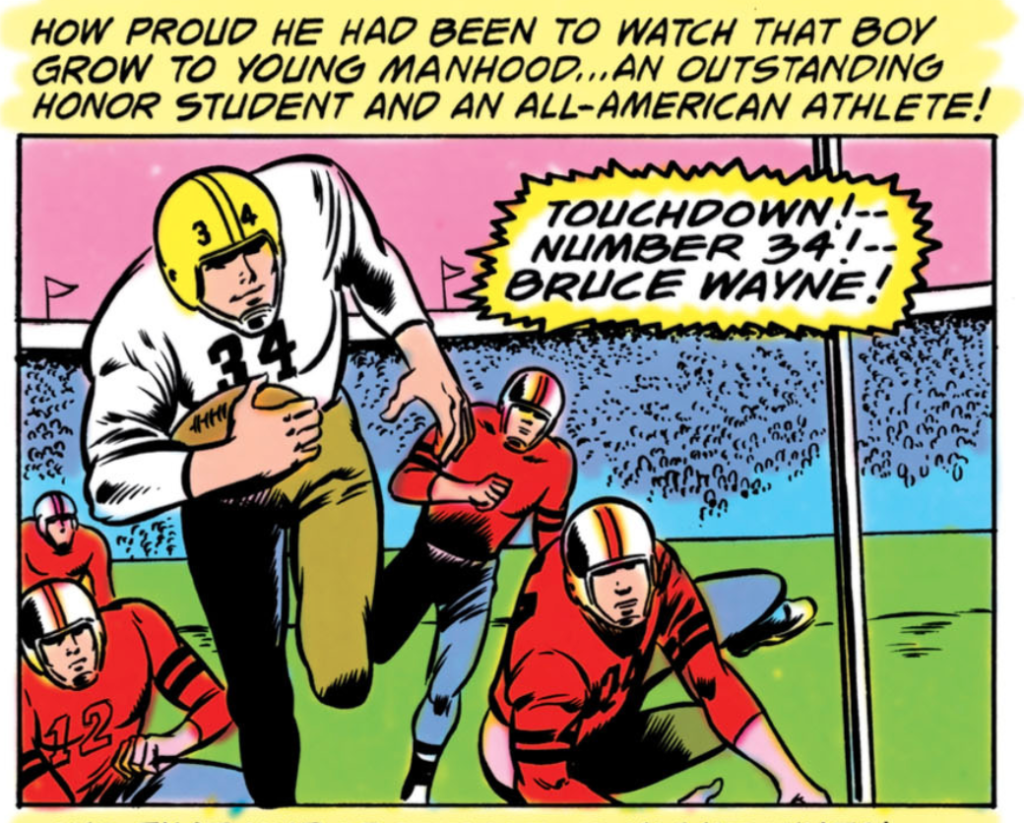
Batman #304 Part 2 by David Vern Reed, Win Mortimer, Frank Chiaramonte, & Jerry Serpe (1978)
1964-1966 (College Years)
Flashback from Batman #208, Batman #188 Part 1, and Batman #304 Part 2—and also referenced in Batman #165 Part 1, Batman #178 Part 1, Batman #208, Batman #165 Part 2, Batman #188 Part 1, Detective Comics #352, Batman with Robin the Boy Wonder News Strip 11/1/1968, Justice League of America #66, Batman #275, The Brave and The Bold #133, and The Brave and The Bold #196. At age eighteen, Bruce enters Gotham College as a criminology major. He rooms with Andrew Warner, becoming friends with Warner and sharing a physics class with him (as referenced in Batman #165 Part 1). Bruce also befriends aerospace engineering major Hank Nelson (as referenced in Batman #178 Part 1). In his freshman year, Bruce qualifies for the 1964 Summer Olympics and competes at the October-held games in Tokyo where he wins a gold medal in hammer throw (as referenced in Batman with Robin the Boy Wonder News Strip 11/1/1968)! As a hobby, Bruce learns how to do card tricks (as referenced in ‘tec #352). Also in his freshman year, Bruce begins wearing an aftershave that he will become fond enough of to wear for the rest of his life. This may seem trivial, but it will come into play later on. Early in his collegiate career, Bruce also has classes with failing student and general weirdo Lenny Fiasco. At a Winter Carnival, Bruce is crowned “Ice King” and rides in a sleigh alongside “Ice Queen” Celia Smith, with whom Fiasco is in unrequited love. (Both the cologne and Fiasco stuff are flashed-back-to from and referenced in Batman #188 Part 1.) Bruce later begins dating theater major Julie Madison (as seen via flashback/reference in Batman #208). He also joins a fraternity (as referenced in Batman #165 Part 2). During his college days, Bruce also befriends high-society gal Linda Page (as mentioned in Batman #208). Bruce also plays soccer (as referenced in Batman #275) and football (as seen via flashback from Batman #304 Part 2) during his college days. Dr. Douglas Dundee will attend all of Bruce’s sports games. Note that Bruce, as a criminology major, will study forensic science, handwriting analysis, multiple types of law, jurisprudence, methods of policing, security, hoplology, and psychology (as referenced in Batman #201, Justice League of America #66, and The Brave and The Bold #133). Being a genius and a hard-worker, and presumably scheduling more-than-full-time classes round-the-clock, Bruce graduates with honors at age twenty, celebrating his graduation with his proud Uncle Philip and Mom Chilton.[13]
_______________________________
_________________________________________________________________________________________
_______________________________
<<< Intro to Silver/Bronze Age Part 2 <<< | >>> Year One >>>
- [1]COLLIN COLSHER: Some important rules before we actually get going. I’ve included flashbacks in a specific way. If a flashback is first revealed—let’s say in Year 15, hypothetically—the flashback may or may not be mentioned in Year 15, but the actual events that occur in said flashback will be placed one the timeline exactly when they originally occurred attached to bullets enumerated as “flashback.” Similarly, story references will be listed as bullet “references.” And likewise, important narrative events that don’t include Batman will be listed as “notes.” Therefore, any “references,” “flashbacks,” or “notes” occur chronologically at the spot where they are situated on the timeline. Any character names (or group names) highlighted in red denote the first appearance of a reoccurring character (or group). Some of these red items may appear only once in the Bat-verse, but appear elsewhere throughout the DCU, and thus have been given the crimson treatment as well.
Also note that most Silver/Bronze Age comics, like their Golden Age predecessors, contain several stories within each issue (a Part 1, Part 2, or Part 3, etc…). The latter Parts don’t always act as chapters of the same narrative, but instead, more often than not, act as second or third features. For example, Batman might be the focus of a Part 1, but Batgirl might be the focus of an unrelated Part 2 within the same issue. That being said, just because Part 1 and Part 2 share the same issue, it doesn’t mean that they are happening back-to-back. In fact, they could be occurring at very different points on the timeline.
Readers of the Batman Chronology Project should also be aware that certain items might have a specific time or month attached to them, yet have nothing within their texts that give any information in regard to time or month. Usually, if something has a specific month listed beside it and does not have a reason why listed along with it, it has to do with its chrono-spatial relationship with other stories (which may give much more detailed information). Unfortunately, a lot of my specific month listings might not have a “reason why” attached). However, no matter what, there is always a reasoning behind my attachment of a precise month to a story. The process of timeline-building is very exhaustive. Obviously, topical references and editorial notes are taken into account, but so are in-story clues and dialog as well. Then, once I have a bunch of items placed, I cross-check each story with every other story on my timeline to make sure that they aren’t contradicting each other.
One more thing. As stated elsewhere on the website, just about everyone eats, shits, sleeps, brushes their teeth, watches TV, goes to the office, schedules appointments in advance, and celebrates birthdays, anniversaries, and special occasions. Believe it or not, Batman does all these things too. He’s human just like you and me! However, this kind of mundane everyday stuff won’t be on our timeline. Usually, anyway.↩
- [2]COLLIN COLSHER: What is the rule when it comes to addressing retcons while building our timeline? Can narrative be canonized piecemeal from within a single comic? And how do we know a retcon when we see one? My timeline-building methodology doesn’t generally involve picking and choosing pieces of individual comics. Typically, a full issue is either canon or it isn’t. The only time pieces of a single comic get added are via reference (or the occasional dreaded out-and-out retcon). It’s up to the reader to make things fit into the greater puzzle—either by fanwank or caveat citing a retcon/irreconcilable difference. It’s certainly not an exact science—and I’m sure I break my own rules every now and again. But I really try not to. Later issues can retcon pieces of prior issues i.e. the Modern Age example of The Man Who Laughs (2005) retconning the end of Miller’s “Year One” (1987). But prior issues trumping later issues doesn’t usually happen. An exception to this rule would apply to retcons from later published material that is quasi-canonical (or, of course, non-canonical). Here’s the big thing to remember: Not everything contradictory that is written later is meant to be a retcon. Some writers simply make mistakes! It’s up to the reader to determine what is a retcon versus what is a continuity error. In this way, we have a loophole to all of our aforementioned edicts. It’s a difficult process determining what is or isn’t a retcon, and, as said before, it certainly isn’t an exact science with hard rules. Thus, we get caveats that say what needs to be ignored. Honestly, the continuity game is a mug’s game. As stated above, the idea is simply to come up with the best (most sensible) reading order. In my practice, I’ve tried to do this while simultaneously providing detailed explanations into my thinking.↩
- [3]COLLIN COLSHER: Depending on the chronology to which you subscribe, the ages of DC’s characters will fluctuate and don’t hold fast to an exact mathematical science, especially since there are so many contradictory references and time gets retconned so much in the comics. Age tends to be the most subjective part of canon, with many characters—especially younger ones—having a wide range of possible birth years as opposed to one solidly definitive birthday. Despite this, the Batman Chronology Project prides itself on building timelines while keeping the aging of characters specifically in mind. There are plenty of online chronologies that are mere reading orders—and then there are chronologies (like this one) that take into account seasons, birthdays, anniversaries, and holidays (i.e. undeniable markers of the passage of time). Doing this—especially for many characters all at once across a serialized shared universe written by many authors—is a challenge, but it remains at the heart of the Batman Chronology Project. Therefore, with confidence, the Silver/Bronze Age birth-years of major players are as follows:
Bruce Wayne – born in 1946
Kathy Kane – born around 1946
Selina Kyle – born around 1951
Dick Grayson – born in 1957
Barbara Gordon – born in 1954
Alfred Pennyworth – born around 1917
Jim Gordon – born in 1922
Talia al Ghūl – born in the 18th century
Jason Todd – born in 1970Bruce’s birthday as February is taken from the 1976 Super DC Calendar, Batman Family #11, and Bob Rozakis’ “Ask the Answer Man” Q&A letters section of Detective Comics #494. Notably, the messy 1976 Super DC Calendar is correct when it comes to Bruce’s birthday. However, it’s worth noting that the calendar contains a ton of specific dates, most of which have been retconned or were just plain incorrect from the get-go. As such, the calendar is a quasi-canonical source that should be taken with a grain of salt. Again, sometimes it’s right, but, more often than not, it’s wholly incorrect.↩
- [4]COLLIN COLSHER: This story is said to occur in “midsummer.” Many different countries around the world have different definitions for what “midsummer” means, although most use the term to literally mean somewhere in the middle of summer i.e. late August. However, the 1976 Super DC Calendar specifically places this item in June.↩
- [5]COLLIN COLSHER: How do we know the June 26, 1958 date of the Wayne murders? Let’s take a look at all the references we have in the Silver/Bronze Age and break it down.
–Batman #232 (1971) says summertime.
–Superboy #182 Part 1 (1972) says November 25.
–The 1976 Super DC Calendar says June 8.
–Detective Comics #500 (1981) says the 26th—sans month specificity.
–Batman Special #1 (1984) says June 26, 1958.Tally it all up and you basically have three summer mentions (two June mentions and one without specificity), one November mention (which is from the non-canon Superboy #182 Part 1), and one mention of the 26th sans month specificity.
Since we have three summer references versus one autumn, we’ll go with summer. And since the 1976 Super DC Calendar is known to have a few errors, and we have two mentions of the 26th, we’ll go with Batman Special‘s specific June 26. Notably, Batman Special‘s narrative revolves heavily around the specificity of the Wayne deaths having occurred on June 26, 1958. This further cements June 26 as the correct date. Most scholars and fans list June 26 as the date Thomas and Martha Wayne were killed in the Silver Age.↩
- [6]COLLIN COLSHER: In Batman with Robin the Boy Wonder Sunday News Strip 7/30/1967, Robin says that the Waynes were killed when Bruce was twelve-years-old. Likewise, in Batman #248, Batman says that he began training at age twelve (not including the weight training Bruce was already doing prior to his parents’ deaths), implying that his folks died when he was twelve. The Untold Legend of Batman #1 tells us that Bruce is in pre-adolescence “one year” after the death of his parents. Usually, the term pre-adolescence means pre-teen, but the broader definition could include an age range of nine through thirteen. That’s three solid mentions of age twelve, meaning that Bruce is likely twelve-years-old when his folks are killed, placing the double-murder on June 26, 1958. The only contradictions to Bruce being twelve come from Jim Starlin’s Detective Comics #481 Part 5, in which Batman says he was merely six-years-old when his parents died; Alan Brennert’s Detective Comics #500 Part 1, which says he was eight; and Mike W Barr’s Batman Special #1, which says he was eight as well. Obviously, these references must be regarded as incorrect.↩
- [7]COLLIN COLSHER: While 1920 film version of The Mark of Zorro was a direct inspiration to Bill Finger while fleshing-out Batman in 1939, the movie that the Silver Age Waynes see the night of their murders isn’t a Zorro flick. Detective Comics #500 Part 1 reveals that it’s a Marlon Brando film. (In the Golden Age, it was a Rudolph Valentino film.) It’s not until the Modern Age that The Mark of Zorro (usually the 1940 version of the film) becomes the canonical last thing Thomas and Martha ever see on the silver screen.↩
- [8]COLLIN COLSHER: Baby Van debuts in the Golden Age where he is only nicknamed “Junior.” Only in the Silver Age do we learn that Jane’s baby’s name is Van. We never learn, in either continuity, the father’s name. However, since Jane’s baby is a junior in the Golden Age, it stands to reason that he is a junior in the Silver Age. Presumably, as a junior, Van shares the same name as his dad. Thus, we retroactively obtain the name of Bruce’s cousin Van.↩
- [9]COLLIN COLSHER: Note that Superboy #182 Part 1 shows a Superboy/Bruce Wayne team-up, but this team-up was rendered 100% non-canon by World’s Finest Comics #271. In this non-canon story, Bruce became the masked “Executioner” and teamed-up with Superboy two months after his parents’ deaths.↩
- [10]COLLIN COLSHER: Adventure Comics #253 is a Golden Age issue (published in October 1958). However, Adventure Comics #253 is non-canon on the Golden Age timeline because it depicts Robin time-traveling back to visit a teenage Superboy. Since there was no Superboy on Earth-2, Adventure Comics #253 is canon only on Earth-1, hence its inclusion as a reference here.↩
- [11]COLLIN COLSHER: In Detective Comics #411, Denny O’Neil tells us that Bruce will become “a master of all fighting arts.” We must regard this line as an exaggeration. Mastery of all martial arts is far-fetched, even for Bruce, but it does tell us that he will train in various techniques for the rest of his life. In any case, it’s ludicrous to believe that Bruce could learn every single fighting style (or that he’d even want to). It is possible that Bruce combines bits and pieces from all martial arts styles while mastering a selection.↩
- [12]COLLIN COLSHER: While we are talking about Sir Arthur Conan Doyle, we should mention that Sherlock Holmes is a fictional character in the Silver Age, as confirmed in Action Comics #283 (1961). Interestingly enough, Holmes is a real historical figure in both the Golden Age and Modern Age. Flash Comics #69 Part 4 (1946) shows Hawkman team-up with the extremely elderly retired detective, and Detective Comics #196 (1953) also confirms that Holmes was a real person in on Earth-2. Note that Detective Comics #110 (1946) contains a regrettable continuity error wherein which Holmes is incorrectly referred to as a fictional character. We can assume that Denny O’Neil’s Sherlock Holmes #1 (1975), a one-shot Doyle adaptation, occurs canonically on Earth-2.↩
- [13]COLLIN COLSHER: The Untold Legend of Batman #1 tells us that Bruce starts college at age 18. The 1976 Super DC Calendar and Batman Family #11 tell us Bruce’s birthday is in February. This means the earliest Bruce can realistically start school is in a June-beginning summer trimester. Assuming genius Bruce goes full-time summer, fall, and spring sessions, he could (and would) graduate after completing eight trimesters, which would make him twenty-years-old when he graduates in December 1966.↩


Something you might want to add is that in Batman #109 it mentions that in addition to knowing acrobatics, Bruce is also the only person in the world capable of performing a quadruple somersault.
Thanks, Jon. Missed that one. I will add!
I didn’t find the reference of New Mexico or Korea’s Batman training in Detective Comics #448
PS: Happy New Year
Typo, New Mexico is Detective Comics #449. Still searching for the Korea/taekwondo reference. Thanks for bringing to my attention, though. LMK if you find it before I do!
Amazing work right here, Bruce sounds like a fun guy to hang around with honestly lol.
Batman Vol. 1 #299 mentions that Bruce studied Taekwondo in Korea. I know you’ve been looking for that reference for a while.
Ah ha! Thanks so much Riverdog!
Small correction on Note #5: Detective Comics #500 (1981) doesn’t give November 26th as the night of the Wayne murders. It only says that they occurred on the 26th of the month (or the 21st on the Parallel Earth the story takes place on, because of the Leap Years). So the November date from Superboy #182 is even more of an outlier.
Oh yes, good catch. Definitely a 26th reference sans month specificity. Thanks!